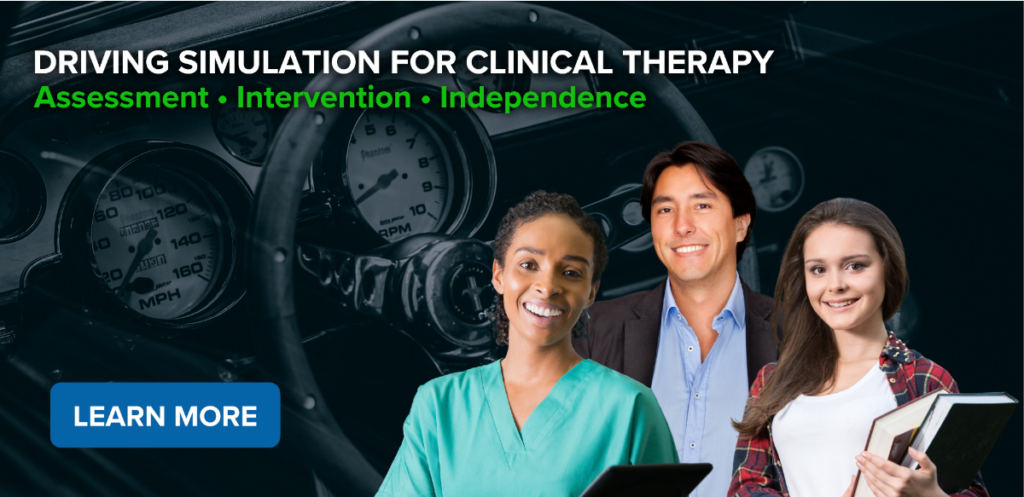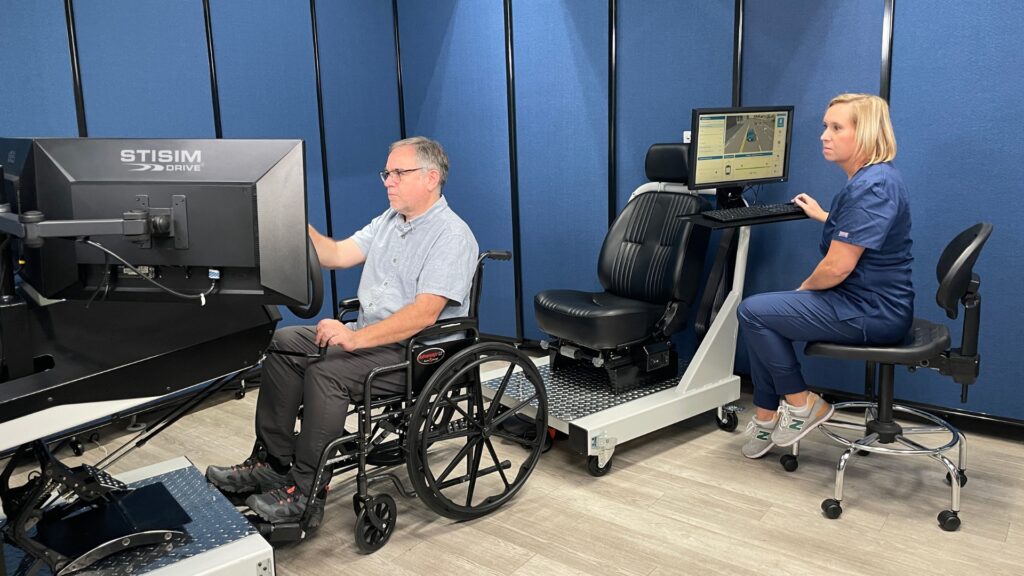The integration of technology in healthcare has revolutionized patient care across many disciplines. At Systems Technology, Inc. (STI), we are proud to be the industry leader in fostering remarkable advancements in clinical therapy through the use of driving simulation technology.
Originally developed for training and research purposes, our technology has emerged as a valuable tool in the realm of rehabilitation. It’s a success story driven by the fact that we have been collaborating with clinical therapists for over 20 years. This has all lead to our most recent release, STISIM Drive G4 – a solution that was developed with clinicians, for clinicians.

“Because G4 was developed from the perspective of the practitioner, our clinical application provides them the most powerful driving simulation tool on the market, for assessment and intervention,” said Fran Nelbach, Director of Product Development for STI. “Our clinical framework was designed to improve patient outcomes, increase patient engagement, and advance therapeutic practice to help patients regain independence and make our communities safer.”
Here’s 9 reasons why driving simulators are a great fit for clinical therapy:
1. Familiarity and High Engagement
The great thing about a driving simulator is that most everybody knows how to drive. Thus, there’s no learning curve for bringing a patient up to speed. With most other medical testing devices, they tend to be intimidated and overwhelmed by the experience, but what we’ve found with STISIM Drive is that patients are typically eager to get in the driving seat. And once they do, they are highly engaged with the experience, as no two drives are ever exactly the same. Whereas with other clinical equipment it’s easy to become bored due to repetition of the same activity over and over.
2. Safe and Controlled Environment
Driving simulators provide a safe and controlled environment for individuals undergoing clinical therapy. Whether it’s regaining driving skills after an accident, recovering from a neurological condition, or addressing specific impairments or deficits, simulators offer a risk-free setting where patients can practice driving without the dangers associated with real-world roads. This controlled environment allows therapists to customize scenarios and challenges based on each patient’s needs.
3. Assessing and Rehabilitating Driving Skills
Driving simulators offer a comprehensive platform for assessing and rehabilitating driving skills. Therapists can evaluate a patient’s cognitive, visual, and motor abilities, reaction times, judgement, and overall driving performance. This assessment helps identify specific areas of impairment and tailor therapy plans accordingly. Simulators also allow therapists to gradually introduce more complex driving situations as patients progress in their rehabilitation journey.
4. Addressing Anxiety and Building Confidence
For individuals who have experienced traumatic events or accidents, anxiety surrounding driving can be a significant barrier to their recovery. Driving simulators provide a controlled and supportive environment where patients can gradually confront and overcome their fears. By exposing patients to simulated driving scenarios and helping them develop coping strategies, therapists can help build confidence and alleviate anxiety associated with driving.
5. Replicating Real-World Situations
Driving simulators offer the ability to replicate real-world driving situations, including different road conditions, weather conditions, traffic patterns, and potential hazards. This realism allows therapists to expose patients to challenging scenarios that they may encounter on the road. For example, with STISIM Drive we offer city, suburban, rural and mountain drives; and we can also select a vehicle that is close to what the patient has. By practicing in a virtual environment, patients can develop the skills necessary to navigate and respond appropriately to various situations, increasing their overall driving competence.
6. Tracking Progress and Monitoring Performance
Driving simulators provide a valuable means of tracking progress and monitoring performance throughout the rehabilitation process. Therapists can analyze objective data captured by the simulator. This includes such metrics as reaction times, errors, and driving metrics, to assess improvements and identify areas that require further attention. With STISIM Drive we also offer driving playback, which allows the clinician to thoroughly share objective feedback with the patient and family members. This data-driven approach allows for more targeted and efficient therapy interventions, optimizing patient outcomes.
7. Individualized Therapy and Adaptability
One of the key advantages of driving simulators in clinical therapy is their adaptability to individual needs. Therapists can tailor scenarios and adjust difficulty levels based on a patient’s abilities, making the therapy sessions personalized and progressive. The simulator’s flexibility allows therapists to modify driving conditions and challenges in real-time, providing a dynamic and engaging rehabilitation experience. With STISIM Drive, a clinician might change the time of day, introduce rain, fog or even high winds.
8. Transfer of Skills to Real-World Driving
The goal of driving simulator-based therapy is to facilitate the transfer of skills learned in the virtual environment to real-world driving situations. By progressively exposing patients to more challenging scenarios and providing targeted interventions, therapists aim to improve overall driving performance and safety on the road. Through practice and reinforcement, patients gain confidence, regain skills, and eventually transition back to driving independently.
9. Provides Great ROI for Clinic Administrators
In the end, we must realize that there is as much of a business side to this as there is a human side. Thus, we can’t forget our clinic administrators that consider, and ultimately decide which technologies their clinics invest in. With STISIM Drive, we offer a great asset that is usable by every discipline in the clinic (OT, PT, SLP), increased billable time, more efficient use of staff resources, improved reputation for patient care, detailed simulator utilization tracking and reporting, and a clinician specific training program, Navigator, that helps staff get the most out of the technology for their patients and the clinic they work for.
Conclusion
Driving simulators open new possibilities in clinical therapy. They have done so by providing a safe, controlled, and customizable environment for rehabilitating driving skills. From assessment to skill-building and confidence-building, our driving simulation technology offers a range of benefits that accelerate progress in rehabilitation. By combining technology with therapeutic expertise, driving simulators play a crucial role in helping individuals regain independence and quality of life following accidents, injuries, or other health conditions.
As technology advances, driving simulators will continue to evolve, further enhancing their effectiveness. And our team at STI will be there leading the way.

